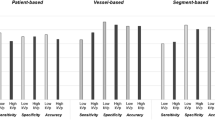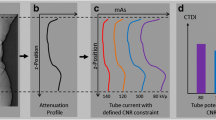Abstract
Objectives
To investigate the relationship between automated tube voltage selection (ATVS) and body mass index (BMI) and its effect on image quality and radiation dose of coronary CT angiography (CCTA).
Methods
We evaluated 272 patients who underwent CCTA with 3rd generation dual-source CT (DSCT). Prospectively ECG-triggered spiral acquisition was performed with automated tube current selection and advanced iterative reconstruction. Tube voltages were selected by ATVS (70-120 kV). BMI, effective dose (ED), and vascular attenuation in the coronary arteries were recorded. Signal-to-noise ratio (SNR) and contrast-to-noise ratio (CNR) were calculated. Five-point scales were used for subjective image quality analysis.
Results
Image quality was rated good to excellent in 98.9 % of examinations without significant differences for proximal and distal attenuation (all p ≥ .0516), whereas image noise was rated significantly higher at 70 kV compared to ≥100 kV (all p < .0266). However, no significant differences were observed in SNR or CNR at 70–120 kV (all p ≥ .0829). Mean ED at 70-120 kV was 1.5 ± 1.2 mSv, 2.4 ± 1.5 mSv, 3.6 ± 2.7 mSv, 5.9 ± 4.0 mSv, 7.9 ± 4.2 mSv, and 10.7 ± 4.1 mSv, respectively (all p ≤ .0414). Correlation analysis showed a moderate association between tube voltage and BMI (r = .639).
Conclusion
ATVS allows individual tube voltage adaptation for CCTA performed with 3rd generation DSCT, resulting in significantly decreased radiation exposure while maintaining image quality.
Key Points
• Automated tube voltage selection allows an individual tube voltage adaption in CCTA.
• A tube voltage-based reduction of contrast medium volume is feasible.
• Image quality was maintained while radiation exposure was significantly decreased.
• A moderate association between tube voltage and body mass index was found.



Similar content being viewed by others
Abbreviations
- ATVS:
-
Automated tube-voltage selection
- CCTA:
-
Coronary CT angiography
- CI:
-
Confidence interval
- CNR:
-
Contrast-to-noise ratio
- DSCT:
-
Dual-source CT
- SNR:
-
Signal-to-noise ratioSSDE: Size-specific dose estimates
References
Meyer M, Haubenreisser H, Schoepf UJ et al (2014) Closing in on the K edge: coronary CT angiography at 100, 80, and 70 kV-initial comparison of a second- versus a third-generation dual-source CT system. Radiology 273:373–382
Zhang LJ, Zhao YE, Schoepf UJ et al (2015) Seventy-Peak Kilovoltage high-pitch thoracic aortic CT angiography without ECG gating: evaluation of image quality and radiation dose. Acad Radiol 22:890–897
Zhang LJ, Qi L, Wang J et al (2014) Feasibility of prospectively ECG-triggered high-pitch coronary CT angiography with 30 mL iodinated contrast agent at 70 kVp: initial experience. Eur Radiol 24:1537–1546
Lu GM, Luo S, Meinel FG et al (2014) High-pitch computed tomography pulmonary angiography with iterative reconstruction at 80 kVp and 20 mL contrast agent volume. Eur Radiol 24:3260–3268
Hell MM, Bittner D, Schuhbaeck A et al (2014) Prospectively ECG-triggered high-pitch coronary angiography with third-generation dual-source CT at 70 kVp tube voltage: feasibility, image quality, radiation dose, and effect of iterative reconstruction. J Cardiovasc Comput Tomogr 8:418–425
Hu L, Wang Y, Hou H, Wei F, Yang G, Chen Y (2014) Radiation dose and image quality with abdominal computed tomography with automated dose-optimized tube voltage selection. J Int Med Res 42:1011–1017
Winklehner A, Gordic S, Lauk E et al (2015) Automated attenuation-based tube voltage selection for body CTA: performance evaluation of 192-slice dual-source CT. Eur Radiol 25:2346–2353
Winklehner A, Goetti R, Baumueller S et al (2011) Automated attenuation-based tube potential selection for thoracoabdominal computed tomography angiography: improved dose effectiveness. Invest Radiol 46:767–773
Goetti R, Winklehner A, Gordic S et al (2012) Automated attenuation-based kilovoltage selection: preliminary observations in patients after endovascular aneurysm repair of the abdominal aorta. AJR Am J Roentgenol 199:W380–385
Siegel MJ, Ramirez-Giraldo JC, Hildebolt C, Bradley D, Schmidt B (2013) Automated low-kilovoltage selection in pediatric computed tomography angiography: phantom study evaluating effects on radiation dose and image quality. Invest Radiol 48:584–589
Schwarz F, Grandl K, Arnoldi A et al (2013) Lowering radiation exposure in CT angiography using automated tube potential selection and optimized iodine delivery rate. AJR Am J Roentgenol 200:W628–634
Layritz C, Muschiol G, Flohr T et al (2013) Automated attenuation-based selection of tube voltage and tube current for coronary CT angiography: reduction of radiation exposure versus a BMI-based strategy with an expert investigator. J Cardiovasc Comput Tomogr 7:303–310
Lurz M, Lell MM, Wuest W et al (2015) Automated tube voltage selection in thoracoabdominal computed tomography at high pitch using a third-generation dual-source scanner: image quality and radiation dose performance. Invest Radiol 50:352–360
Krazinski AW, Meinel FG, Schoepf UJ et al (2014) Reduced radiation dose and improved image quality at cardiovascular CT angiography by automated attenuation-based tube voltage selection: intra-individual comparison. Eur Radiol 24:2677–2684
Spearman JV, Schoepf UJ, Rottenkolber M et al (2015) Effect of automated attenuation-based tube voltage selection on radiation dose at CT: an observational study on a global scale. radiology
Meinel FG, Canstein C, Schoepf UJ et al (2014) Image quality and radiation dose of low tube voltage 3rd generation dual-source coronary CT angiography in obese patients: a phantom study. Eur Radiol 24:1643–1650
Austen WG, Edwards JE, Frye RL et al (1975) A reporting system on patients evaluated for coronary artery disease. Report of the Ad Hoc Committee for Grading of Coronary Artery Disease, Council on Cardiovascular Surgery, American Heart Association. Circulation 51:5–40
Szucs-Farkas Z, Strautz T, Patak MA, Kurmann L, Vock P, Schindera ST (2009) Is body weight the most appropriate criterion to select patients eligible for low-dose pulmonary CT angiography? Analysis of objective and subjective image quality at 80 kVp in 100 patients. Eur Radiol 19:1914–1922
Yuan R, Shuman WP, Earls JP et al (2012) Reduced iodine load at CT pulmonary angiography with dual-energy monochromatic imaging: comparison with standard CT pulmonary angiography--a prospective randomized trial. Radiology 262:290–297
Christner JA, Braun NN, Jacobsen MC, Carter RE, Kofler JM, McCollough CH (2012) Size-specific dose estimates for adult patients at CT of the torso. Radiology 265:841–847
Deak PD, Smal Y, Kalender WA (2010) Multisection CT protocols: sex- and age-specific conversion factors used to determine effective dose from dose-length product. Radiology 257:158–166
Boone JM SK, Cody DD, McCollough CH, McNitt-Gray MF, Toth TL (2011) Size-specific Dose Estimates (SSDE) in Pediatric and Adult Body CT Examinations. Report of Am Assoc Phys Med AAPM Task Group 204 2011 College Park, Md: American Association of Physicists in Medicine
Geyer LL, Glenn GR, De Cecco CN et al (2015) CT evaluation of small-diameter coronary artery stents: effect of an integrated circuit detector with iterative reconstruction. Radiology 276:706–714
Wang R, Schoepf UJ, Wu R et al (2012) Image quality and radiation dose of low dose coronary CT angiography in obese patients: sinogram affirmed iterative reconstruction versus filtered back projection. Eur J Radiol 81:3141–3145
Wang R, Schoepf UJ, Wu R et al (2014) Diagnostic accuracy of coronary CT angiography: comparison of filtered back projection and iterative reconstruction with different strengths. J Comput Assist Tomogr 38:179–184
Moscariello A, Takx RA, Schoepf UJ et al (2011) Coronary CT angiography: image quality, diagnostic accuracy, and potential for radiation dose reduction using a novel iterative image reconstruction technique-comparison with traditional filtered back projection. Eur Radiol 21:2130–2138
Gordic S, Desbiolles L, Stolzmann P et al (2014) Advanced modelled iterative reconstruction for abdominal CT: qualitative and quantitative evaluation. Clin Radiol 69:e497–504
Moore BM, Brady SL, Mirro AE, Kaufman RA (2014) Size-specific dose estimate (SSDE) provides a simple method to calculate organ dose for pediatric CT examinations. Med Phys 41:071917
Leschka S, Stinn B, Schmid F et al (2009) Dual source CT coronary angiography in severely obese patients: trading off temporal resolution and image noise. Invest Radiol 44:720–727
Lee AM, Engel LC, Hui GC et al (2014) Coronary computed tomography angiography at 140 kV versus 120 kV: assessment of image quality and radiation exposure in overweight and moderately obese patients. Acta Radiol 55:554–562
Acknowledgments
The scientific guarantor of this publication is Prof. Dr. U. Joseph Schoepf. The authors of this manuscript declare relationships with the following companies: Dr. Schoepf is a consultant for and receives research support from Astellas, Bayer, Bracco, GE, Medrad, and Siemens. Mr. Canstein is a Siemens employee. The other authors of this manuscript declare no relationships with any companies, whose products or services may be related to the subject matter of the article. The authors state that this work has not received any funding. One of the authors has significant statistical expertise. Institutional Review Board approval was obtained. Written informed consent was waived by the Institutional Review Board. The comprehensive results of automated tube voltage selection presented in this manuscript have not been reported yet. A fraction of the patients in this current study examined at 120 kV were included in a manuscript with a focus on cardiac imaging in morbidly obese patients which is currently under review at European Radiology (EURA-D-15-00876). Methodology: retrospective, cross-sectional, performed at one institution.
Author information
Authors and Affiliations
Corresponding author
Electronic supplementary material
Below is the link to the electronic supplementary material.
Supplementary Table 1
(DOCX 14 kb)
Supplementary Table 2
(DOCX 17 kb)
Supplementary Table 3
(DOCX 14.5 kb)
Rights and permissions
About this article
Cite this article
Mangold, S., Wichmann, J.L., Schoepf, U.J. et al. Automated tube voltage selection for radiation dose and contrast medium reduction at coronary CT angiography using 3rd generation dual-source CT. Eur Radiol 26, 3608–3616 (2016). https://doi.org/10.1007/s00330-015-4191-4
Received:
Revised:
Accepted:
Published:
Issue Date:
DOI: https://doi.org/10.1007/s00330-015-4191-4




